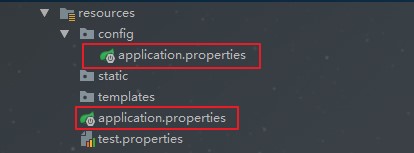介绍
Spring Boot使用了一个全局的配置文件application.properties,放在src/main/resources目录下或者类路径的/config下。Sping Boot的全局配置文件的作用是对一些默认配置的配置值进行修改。比如自定义应用端口号(比较在机器比较少的情况下,一台机器还是需要部署多个应用的,当然利用docker的话,是可避免的,这是后话了)、mq的服务地址、缓存服务的服务地址、数据库的配置等,都或多或少的需要一些外部的配置项等。
springboot默认的全局配置文件名为application.properties或者application.yml(spring官方推荐使用的格式是.yml格式),除此之外还有一个bootstrap的全局文件,它的加载顺序在application配置文件之前,主要是用于在应用程序上下文的引导阶段,springCloudCofnig主要是利用此特性,进行配置文件的动态修改。
自定义配置
application.properties提供自定义属性的支持,这样我们就可以把一些常量配置在这里:
1 | server.port = 8989 |
然后直接在要使用的地方通过注解@Value(value="${config.name}")就可以绑定到你想要的属性上面:
1 |
|
有时候属性太多了,一个个绑定到属性字段上太累,官方提倡绑定一个对象的bean,这里我们建一个ConfigBean.java类,顶部需要使用注解@ConfigurationProperties(prefix = "com.dodd")来指明使用哪个:
1 | //前缀.属性 com.dodd是properties属性com.dodd.name的前缀 |
这里配置完还需要在spring Boot入口类加上@EnableConfigurationProperties并指明要加载哪个bean,如果不写ConfigBean.class,在bean类那边添加:bean类这里可直接加入@Component使其在启动时被自动扫描到,或者使用@EnableConfigurationProperties注解注册此实体bean.
1 |
|
最后在Controller中引入ConfigBean使用即可,如下:
1 |
|
这里需要注意,由于springboot在读取properties文件时,使用的是PropertiesPropertySourceLoader类进行读取,默认读取的编码是ISO 8859-1,故在默认的配置文件中使用中文时,会出现乱码,此时可以将中文转成Unicode编码或者使用yml配置格式(默认就支持utf-8),再不济可以将作为配置写入到一个自定义配置文件,利用@PropertySource注解的encoding属性指定编码。下面是中文乱码的一种解决方法:
添加配置
1
2
3
4
5
6
7#设置spring-boot 编码格式
banner.charset=UTF-8
server.tomcat.uri-encoding=UTF-8
spring.http.encoding.charset=UTF-8
spring.http.encoding.enabled=true
spring.http.encoding.force=true
spring.messages.encoding=UTF-8设置文件类型
将
application.properites的文件类型修改为UTF-8的编码类型。 通过以上方法测试获取出来的值还是乱码。解决方法
IDEA:依次点击 File -> Settings -> Editor -> File Encodings 将Properties Files (*.properties)下的Default encoding for properties files设置为UTF-8,将Transparent native-to-ascii conversion前的勾选上。
参数间调用
在application.properties中的各个参数之间也可以直接引用来使用,就像下面的设置:
1 | com.dodd.name="dodd" |
自定义配置文件
定义一个名为test.properties,路径跟也放在src/main/resources下面:
1 | com.dodd.name = "dodd" |
新建一个bean类,如下:
1 |
|
或者在主类手动引入:
1 |
|
利用@PropertySource注解既可以引入配置文件,需要引入多个时,可使用@PropertySources设置数组,引入多个文件。
这里要注意有一个问题,如果你使用的是1.5以前的版本,那么可以通过locations指定properties文件的位置,这样:
1 | (prefix = "com.dodd",locations="classpath:test.properties") |
但是1.5版本后就没有这个属性了,添加@Configuration和@PropertySource("classpath:test.properties")后才可以读取。
随机值配置
配置文件中${random} 可以用来生成各种不同类型的随机值,从而简化了代码生成的麻烦,例如 生成 int 值、long 值或者 string 字符串:
1 | #随机字符串 |
数组形式
配置文件:
1 | dodd.name="dodd" |
实体类:
1 |
|
测试类:
1 |
|
时间格式化
1 | # 日期格式化 |
外部配置
Spring Boot是基于jar包运行的,打成jar包的程序可以直接通过下面命令运行:
1 | java -jar xx.jar |
实际上,Spring Boot应用程序有多种设置途径,Spring Boot能从多重属性源获得属性,包括如下几种:
- 根目录下的开发工具全局设置属性(当开发工具激活时为
~/.spring-boot-devtools.properties) - 测试中的@TestPropertySource注解
- 测试中的@SpringBootTest#properties注解特性
- 命令行参数
SPRING_APPLICATION_JSON中的属性(环境变量或系统属性中的内联JSON嵌入)ServletConfig初始化参数ServletContext初始化参数- java:comp/env里的JNDI属性
- JVM系统属性
- 操作系统环境变量
- 随机生成的带random.* 前缀的属性(在设置其他属性时,可以应用他们,比如${random.long})
- 应用程序以外的application.properties或者appliaction.yml文件
- 打包在应用程序内的application.properties或者appliaction.yml文件
- 通过@PropertySource标注的属性源
- 默认属性(通过
SpringApplication.setDefaultProperties指定)
这里列表按组优先级排序,也就是说,任何在高优先级属性源里设置的属性都会覆盖低优先级的相同属性,例如我们上面提到的命令行属性就覆盖了application.properties的属性。
配置文件优先级
application.properties和application.yml文件可以放在以下四个位置:
- 外置,在相对于应用程序运行目录的/congfig子目录里。
- 外置,在应用程序运行的目录里
- 内置,在config包内
- 内置,在Classpath根目录
以上按照优先级排序,也就是说,src/main/resources/config下application.properties覆盖src/main/resources下application.properties中相同的属性,如图:

此外,如果你在相同优先级位置同时有application.properties和application.yml,那么application.properties里的属性里面的属性就会覆盖application.yml。
多环境配置
在Spring Boot中多环境配置文件名需要满足application-{profile}.properties的格式,其中{profile}对应你的环境标识,比如:
- application-dev.properties:开发环境
- application-prod.properties:生产环境
想要使用对应的环境,只需要在application.properties中使用spring.profiles.active属性来设置,值对应上面提到的{profile},这里就是指dev、prod这2个。
当然你也可以用命令行启动的时候带上参数:
1 | java -jar xxx.jar --spring.profiles.active=dev |
除了可以用profile的配置文件来分区配置我们的环境变量,在代码里,我们还可以直接用@Profile注解来进行配置,例如数据库配置,这里我们先定义一个接口:
1 | public interface DBConnector { |
分别定义俩个实现类来实现它:
1 | /** |
通过在配置文件激活具体使用哪个实现类:
1 | spring.profiles.active=testdb |
然后就可以这么用了:
1 |
|
除了spring.profiles.active来激活一个或者多个profile之外,还可以用spring.profiles.include来叠加profile:
1 | spring.profiles.active: testdb |